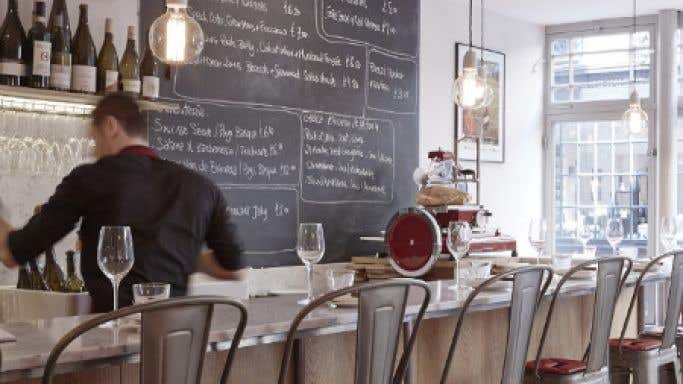Freshness in a dish is an unquantifiable but important ingredient that I seem to crave more and more – and this sensation is due not just to the onset of August. This highly desirable quality is far more than simply an amalgamation of fresh ingredients, and my respect for those chefs who transform the individual items of any dish firstly by cooking them but then apparently adding more by ostensibly doing less, continues to grow.
Japanese cooking first alerted me to this sensation and then it was the turn of the pioneers of California cuisine. The heat of the sun hands an obvious advantage to the talented chefs of Italy, Spain and Australia and I think that it is the growing awareness of the importance of freshness in a dish that has led to the growing popularity recently of the cooking of the Middle East, Peru and Scandinavia. Itamar Srulovich from London's Honey & Co explained on a panel I recently shared with him that the only ingredient he consistently has to import from his native Israel is, surprisingly, coriander because the British version does not add the zing he is looking for.
Freshness was the common factor in dinner at two very different restaurants in central London recently. The first was at Antidote, run by a principally French team but with an English chef, Chris Johns, under Swedish guidance, whose frontage on to the cobbled streets of Newburgh Street close to Oxford Circus gives it a rather Parisian air. The second was at Kirazu in Soho, just north of the theatres on Shaftesbury Avenue, run by Yuya Kikuchi. The restaurant's simple wooden interior is designed by his wife, Sakiko. In each instance, the very different layout of the restaurants dictates how Johns and Kikuchi write their menus that exude such freshness.
Kikuchi was a semi-professional football player in Tokyo before he came to England 17 years ago inspired by his enthusiasm for Triumph motorcycles and the designer Sir Paul Smith. He turned to cooking and worked his way up the ranks of three Japanese restaurants in the capital (he is also licensed to prepare fugu, the potentially lethal blowfish) before deciding to open his vision of the cafe/restaurants he so admires in Osaka.
The Kikuchis' double determination reminded me very strongly of how Jad Youssef and Aga Ilska opened the original Yalla Yalla nearby and how Srulovich and his wife Sarit Packer created Honey & Co, but Kirazu is even smaller. It is no more than 500 sq ft, comprising just 25 seats, and a tiny passageway behind the counter along which Kikuchi scurries as he fulfils the roles of chef and dishwasher.
But because the distance between the kitchen and the customer is no more than a couple of yards, Kikuchi can offer a long menu which the customer fills in, plus a range of what he calls 'seasonal tapas' from a blackboard. When we ate there all the dishes were excitingly fresh but the highlights were tuna, scallop and salmon sashimi served in a razor clam; octopus carpaccio in a spicy marinade with salmon roe; prawn tempura; chicken teriyaki wrapped in a pancake; and a bowl of simmered bamboo and seaweed. And because this is effectively a one-man show, prices are very reasonable.
Antidote's charms are broader, perhaps, as is the list of individuals who have brought back to life a corner site that used to be La Trouvaille (photo above taken from the restaurant's website).
The most obvious is the irrepressible Thierry Bouteloup, who has worked as general manager here for the past 13 years. Last year, he was joined by new backers, all French but ranging from a wine importer via a winemaker to a banker, who have invested in a smart redesign. They in turn wanted to serve the bread that Mikael Jönsson bakes in the basement of his widely acclaimed restaurant, Hedone in west London, but Jönsson was initially reluctant because he felt that the food in Newburgh Street was then not the equal of his bread. The French asked the Swede to be their consultant and Chris Johns was installed.
Johns faces a physical challenge common to many chefs in that his kitchen is in the basement but here this is compounded by the absence of a lift. While this is less of a challenge for the ground floor that offers charcuterie, cheeses and tartines incorporating Jönsson's excellent bread, every dish for the restaurant on the first floor has to be 'run up' by speedy young men, who, perhaps not surprisingly, rarely last long in this role.
Freshness here came in two forms. The first was via a trio of memorable dishes: a cube of slow-cooked pork belly enlivened by San Marzano tomatoes and a mixture of fresh and sautéed endives; the breast, heart and confited leg of duck cleverly offset by miso-glazed courgettes; and two thick, pale slices of Cornish turbot enhanced by a topping of thin slices of gooseberries and very white fresh almonds. The second was an appetising bottle of 2010 Faustine red made by Abbatucci in Ajaccio, Corsica, that was served at an appropriately correct cool temperature.
With this style of food and wine, and the breeze blowing through open windows, it was just possible to imagine we were on an island in the Mediterranean.
Kirazu 47 Rupert Street, London W1D 7PD; tel +44 (0) 20 7494 2248
Antidote 12A Newburgh Street, London W1F 7RR; tel +44 (0) 20 7287 8488

